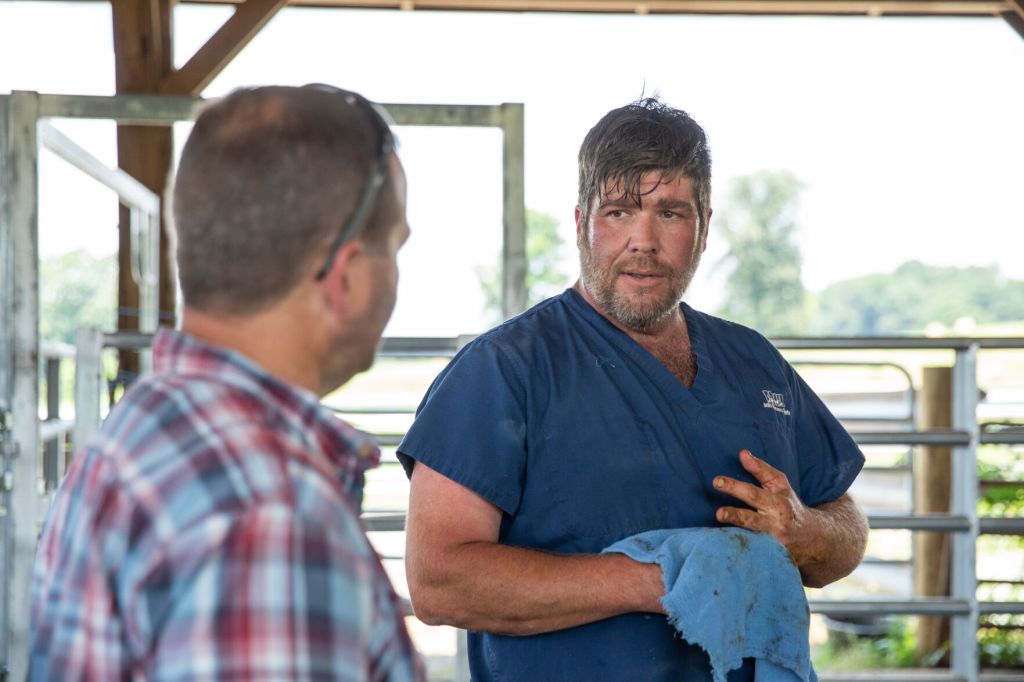‘All that can be done:’ State rural vet loan program to slow existential crisis
Published 2:07 pm Friday, June 28, 2024

- Dr. Roger Thomas, one of the owners of Thomas and England Veterinary Services in Smiths Grove, talks with Jason Smith of WPH Farms in Allen County about a calf’s healing from pink eye on Friday afternoon, June 21, 2024. Thomas said he travels far and wide to accommodate the high demand for large animal care as the Kentucky Rural Veterinary Loan Repayment Program, a new vet student loan repayment program approved by the state legislature this year that offers up to $87,500 in loan repayments over five years to vets who agree to practice on livestock in underserved rural areas or other shortage areas, aims to make a dent in a decades-long rural large animal vet shortage. (Grace Ramey McDowell, Bowling Green Daily News)
One day in mid-June, Dr. Timothy Gardner traveled from his Scottsville veterinary practice to Union County to Webster County to Hopkins County to take calls before journeying back home.
The 300-mile, five-hour trip was no anomaly. The following day, Gardner spent the morning on a pig farm in Allen County, on the Kentucky-Tennessee border, and the afternoon doing cattle work in Harrison County, north of Lexington.
Such is the life of a rural, food animal veterinarian in Kentucky, one of 47 states experiencing a shortage. A new vet student loan repayment program approved by the state legislature this year aims to make a dent in the veterinary desert.
The Kentucky Rural Veterinary Loan Repayment Program offers up to $87,500 in loan repayments over five years to rural vets who agree to practice on livestock in underserved rural areas or other shortage areas.
The program is a culmination of a three-year working group looking into how to best address a decades-long rural large animal vet shortage, said State Rep. Matthew Koch, the bill sponsor.
What are large animal vets?
When most people think of veterinarians, they think of the doctor that takes care of their dog, cat or other household pet. But food animal, or large animal, vets take care of beef and dairy cattle, sheep, goats, pigs and other livestock.
Large animal vets conduct health and pregnancy checks, administer medications, perform surgeries and take sick animal calls at all hours of day and night.
But while they are needed to maintain America’s food supply, many large animal vets are retiring. Not nearly enough younger vets are replacing them, particularly in rural areas.
Nationwide, about 5% of all vets have full-time food animal practices, according to a 2023 study. In Kentucky, that figure is 54 out of 1,695 vets, according to a 2022 Kentucky Department of Agriculture report. Many other vets have mixed practices, dividing their time between small and large animals.
Why is there a rural large animal vet shortage?
Dr. Roger Thomas owns a veterinary practice in Smiths Grove, right outside Bowling Green. He said the physically demanding nature of the work, combined with long hours on the road and the ability to make exponentially more money as a small animal vet makes rural large animal practice unattractive to most.
Dealing with large animals is strenuous, sweaty and potentially dangerous work.
“You come back to the office and work the same amount of time and make five times as much,” Thomas said. ” … It makes you wonder sometimes, ‘Why do I do this?’ ”
For Thomas, the answer is a passion for large animals, instilled in him throughout a childhood spent on a dairy farm. He’s not alone. A 2023 study of hundreds of recent Auburn vet school graduates found that 71% of graduates who reported food animal vet positions in shortage areas were originally from rural communities.
Dr. Kaidy Sullivan, 32, grew up on a cattle farm in Monticello in southeastern Kentucky. While vets from neighboring counties made visits, Wayne County never had a consistent clinic serving large animals when she was growing up.
In 2021, she opened her own mixed animal clinic – Twin Lakes Veterinary Services.
The economics of large animal veterinary medicine are tough to justify, Sullivan said. Vets can see more dogs and cats in a shorter period of time without needing to travel. Plus, they can charge more for services.
“Large animals in itself is a business,” Sullivan said. “Although people may love their cow as much as anybody else loves their dog, the fact of the matter is that cow is only worth so much money.”
While she feels like she has a good work-life balance, Sullivan has to work at it; being on call is part of the job.
“Cows don’t just calve from 8 to 5,” she said.
The Kentucky Rural Veterinary Loan Repayment Program
Sullivan graduated from vet school owing $170,000 in student loans. About $50,000 of that is interest, which began accruing while she was in school and had no time to work, she said.
She just applied to the Kentucky Rural Veterinary Loan Repayment Program. Recipients will get $12,500 their first year and build up to $22,500 in their fifth. People who leave early will forfeit their final years of loan repayment, but won’t face any other penalties.
In 2023, State Rep. Matthew Koch, R-Paris, led the legislative charge to update the Veterinary Medicine Practice Act. The updated law required vets to register with the Kentucky Board of Veterinary Examiners in order to map shortage areas.
Throughout the past few years, Koch said a working group has discussed several potential shortage solutions. They include establishing a veterinary school in Kentucky and re-examining the commonwealth’s relationship with vet schools at Auburn University and Tuskegee University, which both guarantee spots and in-state tuition for Kentucky residents.
But after the map data came back, legislators decided to tackle a loan program first.
According to the American Veterinary Medical Association, vet school graduates with student debt carried an average of $179,500 in loans in 2022.
The 2023 Auburn study found that graduates in food animal positions made an average of $74,000 a year compared to a $85,000 non-food animal salary.
While many Kentucky students may want to return home and set up a small town veterinary practice, economics often forces their hand, Koch said.
“They don’t have that chance because you have such a debt load that they have no choice but to move to a highly urban area to spay and neuter cats and dogs because that’s where the money is,” he said.
Sullivan said the loan application process was simpler than the national USDA loan program. Kentucky’s version also offers more aid – $87,500 versus $75,000 – over five years instead of three. It’s more lenient on what rural vets can practice in order to qualify, too.
Will the rural vet program work?
Thomas turns down at least two or three farm calls a day because they’re 60 or 70 miles away. There aren’t enough hours in the day to address everyone’s needs.
With the decline of farms as agriculture becomes a more commercialized industry, less kids are being raised on farms surrounded by livestock. When they grow up and decide on their career path, less are willing to practice large animal veterinary medicine.
“I know of probably four clinics in our area that were doing mixed animal practice that have said we’re not going to do large animals anymore,” Thomas said. “So it is definitely getting worse.”
He participated in the USDA’s loan program about a decade ago, which covered all but $1,000 of his $76,000 in student loans. School costs and interest rates have skyrocketed since, though, Thomas said.
“I think this program is doing really all that can be done,” he added.
Sullivan thinks it’s a “good start.” She suggested focusing on Kentuckians who are more likely to return to a rural town and work on food animals when considering who to select for limited Auburn and Tuskegee vet school seats.
While many people who weren’t raised in a rural environment may want to work on cattle and horses in a small town, it can be a culture shock, she said. Not everyone stays, she added.
“It’s a way of life,” Sullivan said. “It’s not just a job and a career. And until you’ve been in that way of life, there’s no way to possibly understand it.”

